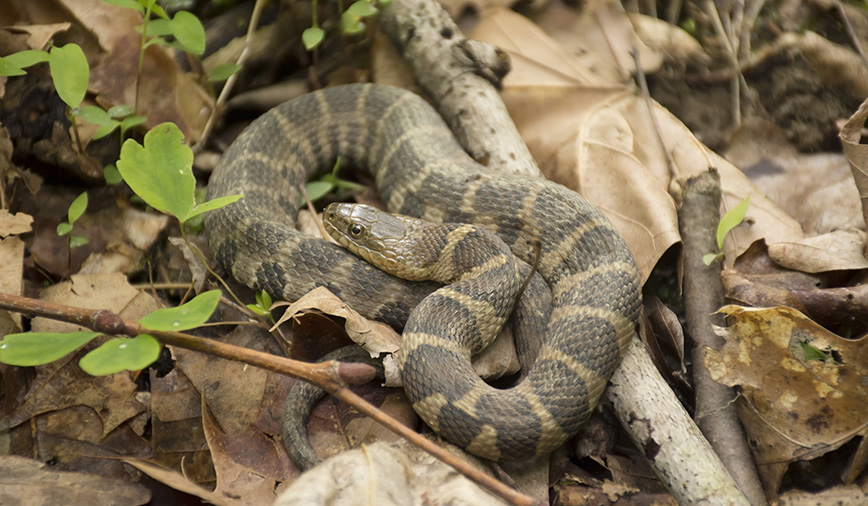October 4, 2013
Water Snakes
Holy Nerodia, Batman! The water snakes are everywhere!
Okay, maybe “everywhere” is an exaggeration. But “everywhere there’s water” isn’t.
Nerodia sipedon sipedon, the northern water snake, has been particularly prevalent this fall, with people up and down the Fox River (and its tributaries) reporting sightings of this medium-sized, blotchy-brown snake. I’ve been asked, by snake lovers and ophidiophobes alike, “What’s up with water snakes?
It’s hard to say for sure, but several factors may have contributed to the species’ apparent increase in numbers. It could be due to last year’s drought, which stranded lots of fish; that in turn made for an abundant supply of food for these piscivorous snakes. Or maybe, due to those plentiful pickings, the herons, egrets and other consumers ate more fish and fewer snakes.
Then again, our reptile friends may simply have been out, taking advantage of some late-season warmth before heading to their winter hibernacula, while people, doing the same thing, just happened to notice.
Whatever the reason, the snakes’ presence caused a bit of a stir. There’s something about dark, heavy-bodied snakes in or near water that really grabs people’s attention. Sipedon’s distinctive brown bands and blotches immediately distinguish it from another common snake, the garter, but also cause it a fair share of trouble.
Many people, noting the snake’s thick body and aquatic nature, immediately assume it to be a venomous cottonmouth. Thankfully, the folks I talked to were relieved to hear our snakes are nonvenomous, and let the issue drop. But I’ve heard about other people who, citing the old adage that “the only good snake is a dead
snake,” quickly dispatch the unfortunate critter, usually with a shovel or rock to the head.
Cottonmouths, a.k.a. water moccasins, a.k.a. Agkistrodon piscivorus, live only in extreme southern Illinois (and, for the record, shouldn’t be killed either). Northern water snakes, by contrast, can be found statewide, and are particularly at home in the Fox River Valley. Our numerous rocky-banked streams and ponds offer near-perfect habitat for basking; meanwhile food, even in non-drought years, is ample.
Fishermen sometimes slander this snake, protesting that it reduces fish populations. But this belief, too, is inaccurate. Healthy gamefish are too large, fast and strong for a water snake to capture. Instead, this snake feasts on sick and weak individuals, a practice that actually improves the health of fish populations.
Water snakes have a few other habits that have not endeared them to the general public: If harassed, they bite. Repeatedly. They release a strong musk. Effortlessly. They void feces. Copiously. And if disturbed just after a meal, they often regurgitate. And that’s just gross.
But if you leave them alone, they’ll return the favor.
Younger northern water snakes are identified by a unique set of markings. The brown bands at the snake’s neck become blotches along the back. Underneath, the snake’s belly is light colored and usually is flecked with red or brown half-moon shaped spots.
But just as humans change with age, so do snakes. Older individuals may darken considerably, to the point of appearing almost black…like a cottonmouth…but they’re not.
Tomorrow’s cool temperatures may send the snakes, and the humans who watch them, heading under cover. But we could have another warm spell or two before winter sets in. Should you venture out along the Fox and its tributaries this fall, keep an eye open for the northern water snake. Admire it for its graceful beauty. Appreciate the role it plays in our local ecology. And remember, look… but don’t touch!
Pam Otto is the manager of nature programs and interpretive services at the Hickory Knolls Discovery Center, a facility of the St. Charles Park District. She can be reached at potto@stcparks.org or 630-513-4346.

